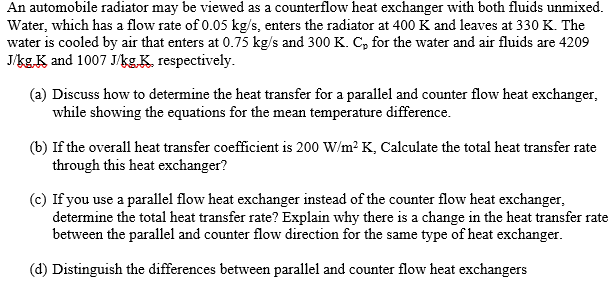Water, which has a flow rate of 0.05 kg/s, enters the radiator at 400 K and leaves at 330 K. The water is cooled by air that enters at 0.75 kg/s and 300 K. C, for the water and air fluids are 4209 J/kg.K and 1007 J/ks.K. respectively. (a) Discuss how to determine the heat transfer for a parallel and counter flow heat exchanger, while showing the equations for the mean temperature difference. (b) If the overall heat transfer coefficient is 200 W/m? K, Calculate the total heat transfer rate through this heat exchanger? (c) If you use a parallel flow heat exchanger instead of the counter flow heat exchanger, determine the total heat transfer rate? Explain why there is a change in the heat transfer rate between the parallel and counter flow direction for the same type of heat exchanger. (d) Distinguish the differences between parallel and counter flow heat exchangers
Water, which has a flow rate of 0.05 kg/s, enters the radiator at 400 K and leaves at 330 K. The water is cooled by air that enters at 0.75 kg/s and 300 K. C, for the water and air fluids are 4209 J/kg.K and 1007 J/ks.K. respectively. (a) Discuss how to determine the heat transfer for a parallel and counter flow heat exchanger, while showing the equations for the mean temperature difference. (b) If the overall heat transfer coefficient is 200 W/m? K, Calculate the total heat transfer rate through this heat exchanger? (c) If you use a parallel flow heat exchanger instead of the counter flow heat exchanger, determine the total heat transfer rate? Explain why there is a change in the heat transfer rate between the parallel and counter flow direction for the same type of heat exchanger. (d) Distinguish the differences between parallel and counter flow heat exchangers
Principles of Heat Transfer (Activate Learning with these NEW titles from Engineering!)
8th Edition
ISBN:9781305387102
Author:Kreith, Frank; Manglik, Raj M.
Publisher:Kreith, Frank; Manglik, Raj M.
Chapter10: Heat Exchangers
Section: Chapter Questions
Problem 10.31P
Related questions
Question
just b

Transcribed Image Text:An automobile radiator may be viewed as a counterflow heat exchanger with both fluids unmixed.
Water, which has a flow rate of 0.05 kg/s, enters the radiator at 400 K and leaves at 330 K. The
water is cooled by air that enters at 0.75 kg/s and 300 K. C, for the water and air fluids are 4209
J/kgK and 1007 Jkg.K. respectively.
(a) Discuss how to determine the heat transfer for a parallel and counter flow heat exchanger,
while showing the equations for the mean temperature difference.
(b) If the overall heat transfer coefficient is 200 W/m? K, Calculate the total heat transfer rate
through this heat exchanger?
(c) If you use a parallel flow heat exchanger instead of the counter flow heat exchanger,
determine the total heat transfer rate? Explain why there is a change in the heat transfer rate
between the parallel and counter flow direction for the same type of heat exchanger.
(d) Distinguish the differences between parallel and counter flow heat exchangers
Expert Solution
This question has been solved!
Explore an expertly crafted, step-by-step solution for a thorough understanding of key concepts.
This is a popular solution!
Trending now
This is a popular solution!
Step by step
Solved in 3 steps with 3 images

Knowledge Booster
Learn more about
Need a deep-dive on the concept behind this application? Look no further. Learn more about this topic, mechanical-engineering and related others by exploring similar questions and additional content below.Recommended textbooks for you

Principles of Heat Transfer (Activate Learning wi…
Mechanical Engineering
ISBN:
9781305387102
Author:
Kreith, Frank; Manglik, Raj M.
Publisher:
Cengage Learning

Refrigeration and Air Conditioning Technology (Mi…
Mechanical Engineering
ISBN:
9781305578296
Author:
John Tomczyk, Eugene Silberstein, Bill Whitman, Bill Johnson
Publisher:
Cengage Learning

Principles of Heat Transfer (Activate Learning wi…
Mechanical Engineering
ISBN:
9781305387102
Author:
Kreith, Frank; Manglik, Raj M.
Publisher:
Cengage Learning

Refrigeration and Air Conditioning Technology (Mi…
Mechanical Engineering
ISBN:
9781305578296
Author:
John Tomczyk, Eugene Silberstein, Bill Whitman, Bill Johnson
Publisher:
Cengage Learning